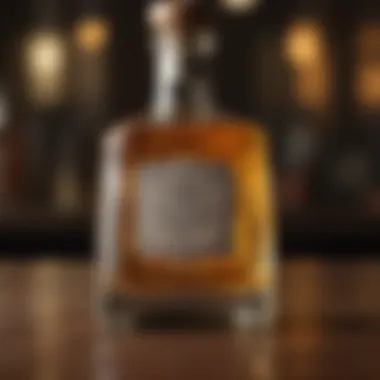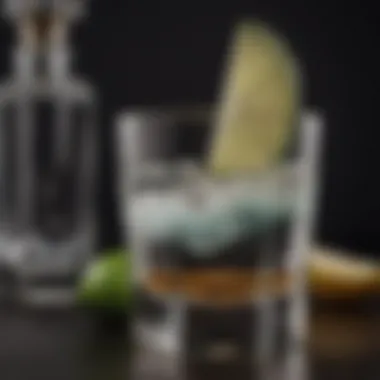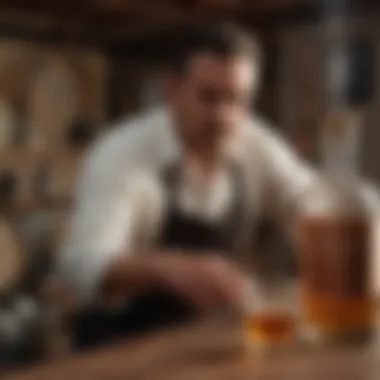Exploring the Finest Tequilas: A Quality Spirits Guide


Intro
Tequila holds a unique place in the pantheon of spirits. Its heritage is intertwined deeply with Mexican culture, and it is made from the blue agave plant, a species native to Mexico. The diversity in its flavors, production processes, and regional characteristics can elevate every occasion, from casual gatherings to sophisticated tastings. This guide explores some of the finest tequilas available. Each selection is examined for what makes it distinct, paying attention to factors such as production methods and flavor profiles.
Understanding tequila extends beyond mere tasting. The category includes several varieties, ranging from Blanco to Añejo and extra Añejo, each presenting its own nuances and culinary potential. Whether you are a seasoned tequila aficionado or just starting, learning about top-tier options will undeniably elevate appreciation for this versatile spirit.
This exploration does not just rank brands; it speaks to the art and craft behind tequila-making. The criteria considered for selection include craftsmanship, unique qualities imparted by terroir, and flavor attributes that resonate with a sophisticated palate. Notably, the way tequila is produced radically influences its taste.
This article intends to provide tools and insights necessary for understanding each tequila's nuances, shaping your choices when pursuing exceptional spirits. Stay with us as we embark on this detailed exploration.
Criteria for Selection
In order to appreciate the qualities of top tequilas, several key elements warrant consideration:
- Production Process: The technique involved in distillation and aging markedly impacts flavor.
- Terroir: The geographical origin influences the growth of agave and the final product.
- Flavor Profile: Tasting notes reflect the ingredients and aging process.
- Aging Time: Each tequila can spend varying lengths of time in barrels, which impart distinct flavors.
The examination of these elements leads to a more profound understanding of tequila's artistry. By assessing each element critically, consumers can make informed choices that enhance their experience over time.
From production secrets to the lingering aroma of oak barrels, this article reveals the delicate balance of tradition and innovation that shapes the world of quality tequilas. Throughout this guide, you will encounter not only the quantitative analysis of the smoothest spirits but also the spirit of appreciation that each bottle encapsulates.
Preface to Tequila
Tequila is more than just a type of spirit; it embodies a rich cultural heritage and intricate craftsmanship that date back centuries. Understanding tequila assists in tanto appreciating its unique characteristics as anyone reveling in a glass of it. Each bottle has a story of its own tied to the soil, plants, and skilled people behind its creation.
Historical Context
Tequila tracesits roots to the indigenous people of Mexico, particularly the region near Tequila, Jalisco. The first distillation of agave liquor—a precursor to what we today know as tequila—occurred in the 16th century following the arrival of Spanish settlers. The blue agave plant became the most notable source of this spirit. The drink began slowly to gain respect beyond regional borders, with several distilleries popping up over the centuries to capitalize on the unique properties of agave. The industrialization during the mid-19th century further propelled the production of tequila into the market, laying the foundation for modern times when it stands proud as both a symbol of cultural identity and a global beverage of choice.
Types of Tequila
Tequila can be classified into four main types: Blanco, Reposado, Añejo, and Extra Añejo. Each type offers a distinct flavor profile and is produced differently, lending itself to various preferences and occasions.
Blanco
Blanco, also often called Plata, is the purest form of tequila. It comes from fresh agave and is bottled after distillation or placed in stainless steel tanks for a short period. This means that it offers vibrant and bold flavors inherent to agave. People turn to Blanco for its versatility; it can be enjoyed straight, blended into cocktails, or used in traditional mixers, making it suitable for most situations.
Its key characteristic is freshness, coupled with a hint of sweetness and pepper notes. One advantage of Blanco is that it retains the unique flavors of the agave plant undiluted, which provides a remarkable experience for those longing to taste the spirit's traditional essence. Not, however, it may be potentially harsh for whisky drinkers, without the softening notes associated with aged reposados or añejos.
Reposado
Reposado sits between Blanco and Añejo due to its shorter aging period, typically between two months and one year in oak barrels. This aging process adds subtle notes of vanilla, caramel, and spices while allowing the agave flavor to remain prominent.
The bespoke advantage of Reposado lies in blending freshness and depth. Consumers appreciate this type due to its balance, as it open thoughtfully combines hints added by the wood while retaining essential agave characteristics. The process creates a spirit that can often be savored straight or serves smartly as a compound in elevated cocktails, creating luxurious impressions.
However, one must recognize its flavor complexity may overwhelm newcomers to tequila, making it essential for recognizable food pairing genies.
Añejo
Añejo is a premium offering in the tequila hierarchy. It is aged for a minimum of one year but less than three years in oak barrels, resulting in deeper flavors and a smoother finish. Through this gentle maturation, Añejo develops intricate layers of spices, caramel, and slight smokiness, which can provide an indulgent sip.
For aficionados, the specific aspect of Añejo's extended aging means greater character. Fans swear by its exceptional smoothness, making it often perceived as an elevated experience capable of holding its on both neat or rocks. Sometimes, it may find success accompanying fine cigars, enriching the experience even further.
There are downsides too, as Añejo's pricing typically reflects its artistry and refinement which could be a roadblock for some drama as the wallet sacrifices may not suit everyone's preferences.


Extra Añejo
Extra Añejo takes the aging process even further—aged for a minimum of thee years. This tantalizing type of tequila dives headfirst into opulence with its weighty, robust flavors developed from extensive barrel time.
Those bundled with taste buds searching themes of complexity will find delight in its multi-dimensional offering. Extra Añejo is suited for enthusiasts ready to go beyond casual sipping, often experiencing earthy tones, remarkable oak influence, and slightly smoky finishes. This uncompromising depth can command an exclusive appreciation but matches the premium price tag to its quality and intensity.
Experiencing Extra Añejo often implies treats reserved for specific occasions.
Criteria for Selecting Top Tequilas
Selecting quality tequila involves careful evaluation of specific criteria that ensure the spirit's excellence. It is important to recognize these criteria because they define the differences in taste and overall experience among various tequilas. Knowing what to look for can enhance the appreciation of this traditional Mexican spirit.
Production Methods
The production methods employed in crafting tequila play an crucial role in the final product. Typically, the process starts with the harvesting of mature agave plants, particularly the blue Weber agave. This is followed by cooking the piñas, which are the hearts of the agave, in traditional ovens or autoclaves.
Once cooked, the agave undergoes fermentation using natural yeasts or commercial strains, where sugars convert to alcohol. Finally, distillation takes place, often twice, to refine and purify. Different producers employ varying methods, which also adds interesting nuances to the flavor profile. Understanding these methods helps consumers to appreciate the complexity involved, leading to better selections.
Aging Process
Aging is another key criterion influencing tequila selection. It reflects how long the tequila has been stored in wooden barrels to develop flavors. There are four main categories based on aging: Blanco, Reposado, Añejo, and Extra Añejo, each representing varying periods of barrel aging.
- Blanco: Usually unaged or aged for less than two months. It retains agave's bright flavors.
- Reposado: Aged between two months and one year, which mellows its taste.
- Añejo: Aged one to three years, develops deeper flavors from longer contact with wood.
- Extra Añejo: This tequila ages for over three years, resulting in a smoother finish.
The aging process is instrumental in establishing unique taste profiles, thereby impacting one’s choice based on personal preference.
Flavor Profile Characteristics
Evaluating the flavor profile is essential for selecting top tequilas. This encompasses three areas: aromatics, taste, and finish.
Aromatics
The aromatics of tequila are often the first sensory experience and play a significant role in how one perceives the spirit. A well-crafted tequila can present a variety of aromas, such as floral, herbal, or even fruity notes. These scents provide insight into the production methods and agave's maturity.
Key characteristics include:
- Complexity: A tequila with layered aromatic profiles suggests sophisticated production methods and quality ingredients.
- Freshness: Lively, vibrant aromatics can indicate a well-made Blanco.
Such distinctions make aromatics a vital consideration in evaluating a tequila's quality and appeal.
Taste
Regarding taste, one must consider how flavors of various components converge. Quality tequilas can range from herbal notes to fruity and earthy tones. The complexity enhances drinkability, captivating the consumer’s palate.
Unique features involve:
- Balance: Good tequila presents a nice balance of sweetness, bitterness, and acidity.
- Legacy of Taste: Age can contribute to a richer, more profound flavor experience.
Taste serves as a clear indicator of quality and influences beverage pairing options.
Finish
The finish of tequila reflects what remains on the palate after tasting. A long, pleasing finish is often a sign of quality. Full-bodied and smooth spirits enhance the overall experience versus a short, harsh finish.


Aspects to appreciate:
- Longevity: A finish that lingers allows consumers to savor flavors further.
- Refinement: Drinks with a smooth finish minimize immediate harshness, leading to a gentler taste overall.
A shorter finish may indicate lower quality, making this aspect crucial for discerning palates.
A comprehensive understanding of production methods, aging, and flavor characteristics significantly enhances one’s ability to select premium tequila.
Top Tequila Selections
Selecting top tequilas means more than just viewing labels and tasting. It indicates a connection to tradition, craftsmanship, and an appreciation of flavors. Noise from various tequila brands may overwhelm consumers, making a concise identification of quality essential. This section aims to shed light on distinct selections, enlightening readers regarding their features and benefits, bringing more clarity to their choices.
First Choice: Patrón Silver
Taste Profile
Patrón Silver tequila is recognized for its bright, crisp taste. This quality is attributed to the use of pure blue agave, double distillation, and filtration processes. The smoothness of the spirit contributes to its popularity. Notes of fresh citrus, herbal hints, and a light sweetness define its flavor, making it a versatile choice both neat and in cocktails. The clean finish makes it notable among peers. This balance of flavors resonates well with those preferring a clean palate. Patrón Silver stands as an beneficial choice, especially for consumers new to quality spirits.
Recommended Cocktails
Patrón Silver is an excellent base for various cocktails, elevating their overall quality. Classic margaritas developed with this tequila highlight the bright agave notes effectively. Mixing with fresh lime juice and a hint of orange liqueur fuses the flavors seamlessly. This versatility makes it very useful for bartenders and enthusiasts alike. Yet, the distinctive flavors also hold when sipped alone, allowing for a unique experience every time.
Serving Suggestions
Serving Patrón Silver chilled enhances its flavor, exhibiting crisp notes even further. Simple glassware such as a highball or shot glass emphasizing its sleek craftsmanship is often recommended. The purity of lines combined with neat presentation embodies elegance within simplicity, focusing on the beverage itself. More elaborate margarita presentations dueto garnishes can greatly attract attention will also work effectively. Patrón offers room for personal creativity.
Second Choice: Don Julio Añejo
Taste Profile
Don Julio Añejo showcases greater depth produced by a longer aging process in American white oak barrels. It brings complexity to the table with a palette combining woody notes and rich creaminess. Rich caramel and subtle spice complications finish in softness, capturing consumers’ interests keen on richer spirits. This characteristic aging makes it apreferred option for seasoned tequila connoisseurs and the ones discovering deeper flavors in spirits.
Recommended Cocktails
Considering how well rounded Don Julio Añejo is, it pairs beautifully with many different mixers. Although sipping neat captures its true essence fully, its luxurious structure complements other powerful flavors from premium cocktails. Adding ingredients like Angostura bitters can create a complex, slightly lighter twist perfect for an after-dinner drink. Balancing these ingredients will keep the tequila upfront while integrating harmoniously into the overall experience.
Serving Suggestions
Best served at room temperature, Don Julio Añejo should come in a glass that allows exploring its rich aromas like a snifter might deliver perfectly. Some suggest decanting it for a more intense experience. On occasion, pairing it with dark chocolate enhances the robust flavors. This monumental adjustment leads to an indulgent experience necessary worthy of selecting higher-end spirits.
Third Choice: Casa Noble Reposado
Taste Profile
Casa Noble Reposado draws attention through its unique production methods. Resting in French oak barrels introduces floral notes, mesquite, and hints of vanilla. It achieves a flavor profile defining shades of both traditional and unorthodox elements, pleasing numerous palate varieties. This fragrance influences smoothness key that makes it appealing, presenting principles associated with a fine tequila—ideal balance, complexity, and richness.
Recommended Cocktails
For crafting cocktails, Casa Noble Reposado contributes significantly towards creating flavorful, smooth blends. Its soft, rich profile consists well alongside lighter ingredients. A classic tequila sunrise or, alternatively, a more creative rendition involving berry purity could produce a stunning visual mix. The aromatic notes also entice diverse combinations facilitating, ideally accommodating varied tastes with ease.
Serving Suggestions
The preferred method of serving Casa Noble Reposado usually involves chilled glasses to enhance its prominent notes. Furthermore, glass tumblers allowing free air naye? promotes sensory exploration enjoying the tequila even more. Pair with culinary delicacies like citrus marinated seafood and pickled vegetables where it completes the essence while elevating dining experiences proving versatility needs not ignored.


Understanding Terroir in Tequila
The concept of terroir in tequila plays a crucial role in defining the unique qualities of this spirit. Rooted in geography, climate, and soil composition, terroir directly affects the flavor profiles and overall characteristics of tequila. Understanding how these factors contribute to the quality of the spirit gives consumers a deeper appreciation and insight into their selections.
Significance of Agave Source
Agave is the foundation of tequila production. The type and source of agave plants are vital for the flavor and quality of the final product. Different regions host varied species of agave, impacting sweetness, mineral content, and ultimately the taste. High-quality tequilas often use Blue Weber Agave, primarily found in the Tequila region, which is known for its distinctive flavor.
Producers who focus on the integrity of their agave sourcing tend to highlight the importance of sustainable farming practices. This means employing environmentally friendly techniques that preserve the land. Many distilleries cultivate their agave for several years before harvesting. This commitment to excellence shows in the resultant products, with smoother textures and richer flavors that differentiates superior tequila from mass-produced options.
Geographical Influence
The geographical location where agave is grown influences its final flavor brightly. For instance, high-altitude locations often yield agave that has a different thickness and sugar concentration than those grown at lower elevations. The soil type contributes paramount aspects too. Rich volcanic soils typically impart mineral characteristics into the agave, enhancing the profile of the tequila.
Moreover, climatic conditions such as temperature and rainfall also play significant roles. Agave cultivated in regions with drier climates often retains more concentrated flavor profiles while showcasing unique botanicals attributed to local environmental conditions.
In summary, a tequila's excellence can stem directly from the interplay of agave sourcing and geographical attributes. By understanding the terroir, consumers gain valuable insights into the complexity and heritage of their spirit, amplifying the overall tasting experience.
The source and location of agave not only enhance flavors but also create a narrative behind each bottle, making every sip a reflection of its origins.
Comparative Analysis of Selected Tequilas
The comparative analysis of selected tequilas is a crucial aspect of understanding the finer qualities of these spirits. By engaging in a structured comparison, consumers can evaluate the factors affecting flavor, cost, and overall reception. It provides a clear perspective on what makes each tequila unique, thus aiding enthusiasts, collectors, and casual drinkers alike in making informed choices.
Flavor Comparisons
When analyzing flavor profiles among tequilas, it is beneficial to look at various elements such as aroma, taste, and the finish of the spirit. Patrón Silver often showcases bright, citrusy notes complemented by a light herbal undertone. In contrast, Don Julio Añejo possesses richer caramel and vanilla tones due to its aging process, balanced with subtle spice notes. Casa Noble Reposado presents a fusion of floral and earthy elements, enhanced by its time in oak barrels.
Understanding these distinctions allows drinkers to appreciate the craftsmanship behind each brand. It is essential to note factors such as the agave type, terroir, and production methods contribute to these diverse flavor profiles. The ability to draw comparisons encourages a broader appreciation for the art of tequila making.
Price Point Analysis
The pricing of tequila can fluctuate significantly based on several aspects like production quality, aging process, and market demand. Patrón Silver, with its premium positioning, tends to be on the higher end of the pricing spectrum. On the contrary, Casa Noble Reposado is often more accessible without compromising flavor integrity.
Pricing should also resonate with the quality offered. A higher cost often correlates with meticulous production processes and the use of superior agave. Internally assessing value based on flavor experience will enrich the tequila selection experience. Looking into limited editions or specific releases may reveal investment-worthy options.Binding frugal constraints while not compromising delight remains a tall order, but knowing the price points helps balance enjoyment and cost.
Market Reception
The general reception of tequilas plays a substantial role in shaping consumer preferences. Patrón is frequently regarded as a go-to tequila, especially among new users. This brand’s broad awareness ensures its position in the market and affirms its popularity.
Furthermore, Don Julio Añejo enjoys respect within whiskey circles for complex flavors, appealing to those seeking something beyond the typical spirit. The reputation of these brands can heavily influence consumer choice and encourage loyalty. However, smaller or emerging brands like Casa Noble Reposado can offer both innovative tastes and experiences for well-rounded drinkers willing to explore alternatives. The varied reception indicates a dynamic fluidity in consumer tastes towards established and artisanal brands alike.
Understand that awareness of different brands enhances your tequila experience, pushing boundaries instead of sticking to the usual labels of mass appeal.
In summary, conducting a comparative oanalysis provides valuable insights into the richness of the tequila world. It empowers consumers to navigate choices more credibly and confidently.
Concluding Remarks
Final Thoughts on Quality Tequila Selection
Selecting a quality tequila is an exercise in discernment. The different types, like Blanco, Reposado, and Añejo, offer various nuances distinct to their aging processes and production methods. Consider the richness that aging brings to flavor, or how the crispness of a Blanco can highlight the pureness of agave. When exploring notable brands, you see how artisanal methods contribute significantly to their character.
Taste tests comparing techniques are crucial. Take notice of how careful mastery impacts aroma and mouthfeel. Quality becomes evident through details; prov..en all throughout this article. On a practical level, explore where the tequila comes from; knowing the origin enhances appreciation and understanding. Mapping agave sources reminds us of the connection between place, heritage, and spirit.
Embracing the Tequila Experience
To appreciate tequila fully, one must embrace the experience that surrounds it. One way to enhance the flavor conversation with anyone is to educate oneself on the history, production methods, and cultural significance behind each sip. Attending tastings is a practical approach to immerse oneself in the subtleties of each pour. The social aspect is just as integral; tequila enjoyed among friends becomes a portal into joyful moments and shared stories.
"True appreciation may stem from understanding both taste and story behind spirits."
Lastly, when selecting a tequila for special occasions or day-to-day enjoyment, keep individual preferences in mind. Not everyone will relish a palate full of spice or a blend with floral notes. Encourage open conversations that lead to surprising discoveries in taste. Such dialogues allow tequila aficionados and novice drinkers alike to forge deeper connections to the spirit.







